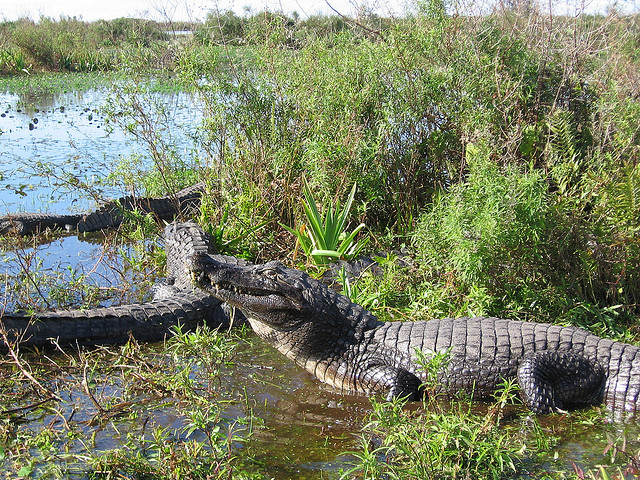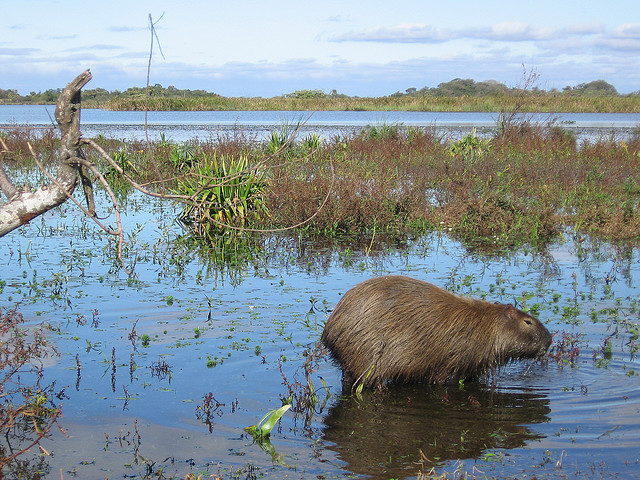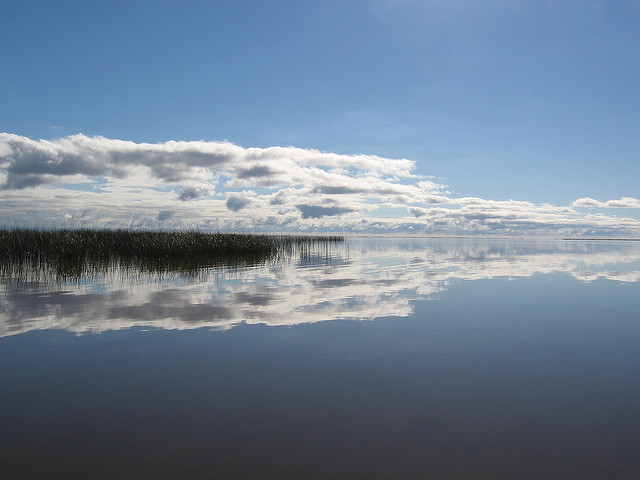
Caiman alligators (their indigenous Guaraní name is yacaré) on a floating island in Los Esteros del Iberá, Argentina. Photo courtesy of Sarah Enelow
My canoe bumped into a floating island, which was a bad thing. Getting too close to an isla flotante meant that the 8-foot caiman alligators on it could step right into my vessel and eviscerate me. I started rowing furiously in the opposite direction, made difficult by the fact that my friend Allison was sitting in the back of the canoe, deliberately rowing toward the island.
“Stop rowing! Abort!” I shouted back at her, my bird-like arms straining to steer us at least two meters away from the island, as we’d been instructed when we rented our canoe. An alligator looked me right in the eye.
“Oh don’t worry, that was just a suggestion,” replied Allison.
“Yeah, a suggestion from a local who still has arms and legs. Besides, I’m in the front of the canoe so I’m the one who’ll get eaten first.”
All things considered, Allison and I were thoroughly enjoying our trip to Los Esteros del Iberá, the remote marshlands of northeast Argentina. We became friends while doing yearlong Fulbright grants, so for the last five months we’d been teaching English elsewhere in the Argentine provinces and this trip was part of our winter break. I originally proposed coming to the marshlands because I wanted to experience an unspoiled, authentic corner of Argentina, which was absurdly rich in natural resources. We rowed along through this natural splendor until I felt a sharp bump under the canoe.
“Did you feel that?” I asked Allison while holding my oar in mid-stroke.
“Yeah, I did…”
“What do you think that was?” I posed, knowing full well that an alligator could capsize our canoe if he wanted to. I shuddered at the thought and peered over the side for other signs of aggressive gators.

Sharing the floating islands of Los Esteros del Iberá, Argentina, are carpinchos (their indigenous Guaraní name is capybara), the world’s largest rodent. Photo courtesy of Sarah Enelow
We rowed out toward the middle of the lagoon and I breathed deeply. Lily pads carpeted the sapphire water, the floating islands were blanketed in green moss, and the sky stretched on forever, reflected mirror-like in the rippling lagoon. All I could hear was the buzzing of dragonfly wings. Now a safe distance from the floating islands, I looked over at one that was filled with alligators, probably nine, I couldn’t quite tell because they were so well camouflaged. Most of them were sunbathing perfectly still, but others were slowly moving about, inching around their mossy patch of land, slipping into the water without splashing a drop, or stretching their jaw muscles, which revealed rows of glistening teeth.
Los Esteros del Iberá owed their majesty and pristine condition in part to the difficulty in reaching them. The nearest real town, called Mercedes, was not at all a major stopover by bus. Visitors typically spent the night in Mercedes, and then took a five-hour bus down a long dirt road to Carlos Pellegrini, the minuscule hamlet that sat right in the marshlands themselves. There was one daily bus from Carlos Pellegrini back to Mercedes, which left at 3am so that people had time to get their business done in town before siesta (going to the bank, seeing a doctor, shopping, etc.).
It may have been a trial to get to Los Esteros del Iberá, but I was particularly thankful for that because it was anything but overrun. Only the most dedicated eco-travelers made their way there, among which were a smattering of biology students studying the caimans, the monkeys, the carpinchos (the world’s largest rodent), or the incredibly diverse bird and plant life.
Allison and I rowed our canoe to shore and walked back to Carlos Pellegrini to have an early dinner. There were a handful of modest cafés, so we picked one at random and sat down to order some gnocchi (a common dish in Northeast Argentina, which has a significant Italian heritage). The owner of the café came over to take our order and we chatted with him in Spanish. There had been two weeks of torrential rain right before our arrival, so the owner told us how difficult it had been to leave the village (that long dirt road flooded easily), get supplies, and keep the damage under control. No one had gotten hurt, but they were out of many staples for several more weeks, for example dough for making empanadas. The owner moved on to a nearby table, where a young man, unshaven in mud-stained clothes, was trying to order with his limited Spanish.
“Hello, caiman milanesa please,” said the young man with confidence, referring to a filet of alligator meat, breaded and fried.
“Excuse me?” replied the owner.
“Caiman, fried, to eat please.”
“I’m sorry, we don’t serve caiman.”
“No?”
“No, they’re endangered.”
“Someone in this village eats alligator, yes?” The young man seemed to think that if he gave the secret password, they would honor him like a local and bring one out on a spit.
“No. This is a nature reserve.”
“But the man who eats alligator, where does he get it?”
“I don’t know anyone who eats caiman.”
“OK, I will try tomorrow,” resigned the young man, who settled for pasta instead.
I looked down and covered my mouth to hide my giggling, partly in amusement but also in awareness that sometimes our idea of an “authentic experience” is terribly divorced from the real thing. It’s possible that the locals were hiding the alligator milanesa because they didn’t want it turning into a commercialized tourist attraction, but then again, maybe it really wasn’t on the menu because these animals really were endangered. Some relentlessly chase that filet of alligator because it’ll become the outlandish anecdote that wows the friends back home, but I would argue that a story about a canoe ride is better when the alligators in the lagoon are alive. There’s a remote chance that they could kill me, but I would rather have the excitement of them hunting me than vice versa.
About the author: Raised in rural Texas, Sarah Enelow currently lives in New York, where she works for a bass luthier. Her travel writing appears on Not For Tourists, The Purple Passport, Travel-Junkie, and WhisperTrail. Read more at enelow.tumblr.com.


From the beauty of lily pads to the wrath in the eyes of an alligator! Wow, what an experience. It’s full of adventures. Take care Sarah!
Rahman Mehraby
TraveList Blog
Posted by Rahman @ Travel Marketing Blog | April 5, 2012, 6:47 pmThis will always be spoken of at family gatherings, I assure you all. May you both have such safe adventures in the future and always tell us these after several years of separation from the events!
Randall
Posted by John Bryan | April 6, 2012, 5:50 pm